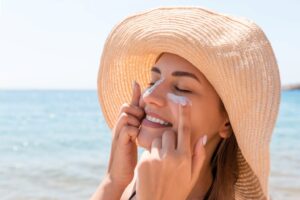When Should I Worry About Sun Damage?

As you probably already know, skin cancer is the most common cause of cancer, with about 9,500 people in the United States diagnosed with a new case every single day. You do your best to protect your skin from the damaging UV rays of the sun, wearing sunscreen every time you step outside and limiting your time outdoors during the heat of the day, and you check yourself regularly for sun damage. Suddenly, despite your best efforts, you discover an unfamiliar spot on your skin. Is it cause for alarm? How do you know when to be concerned?
Skin cancer should never be taken lightly. Sometimes, however, spots on your skin are harmless. How can you tell the difference? Because it can be hard to tell, it’s important to check your skin regularly and become familiar with your own skin. If you notice spots that look unusual, has changed in size, shape, color, or texture, or that itches, bleeds, or doesn’t heal, see your dermatologist as soon as possible.
It’s also smart to know how to identify the three common types of skin cancer. Basal cell carcinoma, squamous cell carcinoma, and melanoma all look different from each other.
- Basal cell carcinoma (BCC) makes up about 70 percent of non-melanoma skin cancer. These growths develop slowly, and if you have one BCC, you’re more likely to develop another. A BCC starts off as a pearly or shiny lump or a scaly area that’s flesh colored, pink, or red, but these spots can become inflamed and ulcerate.
- Squamous cell carcinoma (SCC) can grow very quickly. They’re far rarer than basal cell carcinoma, but if left untreated they can easily spread. SCC can develop anywhere on the body, but they’re especially common on sun-exposed areas. They are thick, red, scaly, or crusted spots that can bleed and become inflamed and are often tender to the touch.
- Melanoma is the least common type of skin cancer but it’s also the most serious. It’s important to catch it early so that it doesn’t spread, because it causes the greatest number of skin cancer deaths. If you have a new spot or an existing spot has changed color, shape, or size, it could be a melanoma. Melanomas can be flat or raised, can be more than one color, and may have an irregular border. Nodular melanoma is an aggressive type of melanoma that spreads quickly deep into the skin, so it’s crucial to catch it early. This kind of melanoma looks like a round, raised lump that’s pink, red, brown, or black, firm to the touch, and may have a crusty surface that bleeds.
What can you do to prevent skin cancer? Protecting your skin from UV radiation is extremely important, as almost all skin cancers are the result of overexposure to the sun. However, the best thing you can do for your skin is to schedule an annual skin exam with a dermatologist. Your dermatologist can find the signs of skin cancer before it progresses, and catching cancer in the early stages is the best way to effectively treat it.
When it’s time for your annual skin exam, contact Swinyer-Woseth Dermatology, a practice committed to providing superior, professional skin care in a manner that’s practical, efficient, and compassionate. With over 30 years of experience providing dermatological services in Salt Lake City, we provide a variety of services, from cosmetic skincare to treatment for skin cancer. Our team of board-certified dermatologists and licensed cosmetic service providers are here to provide you the care you need in a comfortable, professional atmosphere. Call (801) 682-4715 or contact us through our website.
